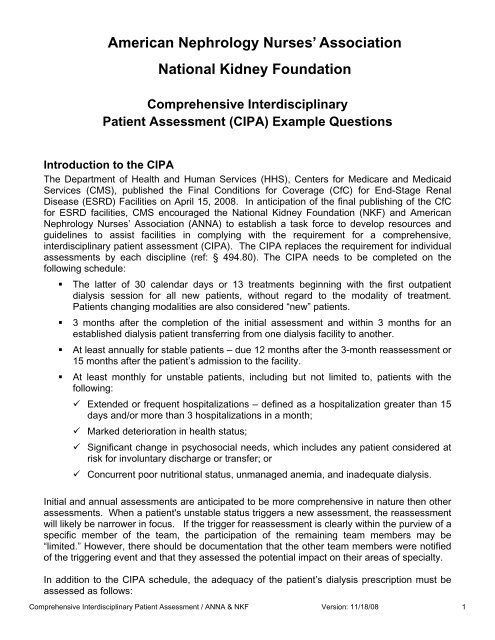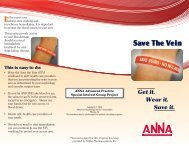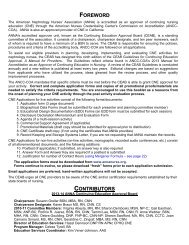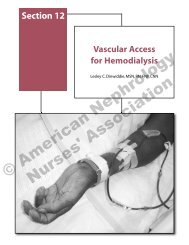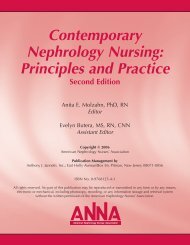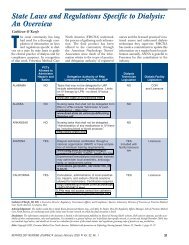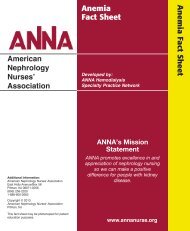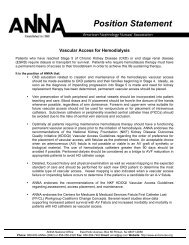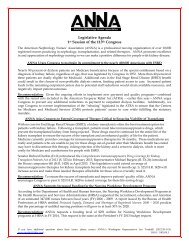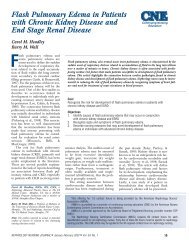PDF file - American Nephrology Nurses Association
PDF file - American Nephrology Nurses Association
PDF file - American Nephrology Nurses Association
You also want an ePaper? Increase the reach of your titles
YUMPU automatically turns print PDFs into web optimized ePapers that Google loves.
<strong>American</strong> <strong>Nephrology</strong> <strong>Nurses</strong>’ <strong>Association</strong><br />
National Kidney Foundation<br />
Comprehensive Interdisciplinary<br />
Patient Assessment (CIPA) Example Questions<br />
Introduction to the CIPA<br />
The Department of Health and Human Services (HHS), Centers for Medicare and Medicaid<br />
Services (CMS), published the Final Conditions for Coverage (CfC) for End-Stage Renal<br />
Disease (ESRD) Facilities on April 15, 2008. In anticipation of the final publishing of the CfC<br />
for ESRD facilities, CMS encouraged the National Kidney Foundation (NKF) and <strong>American</strong><br />
<strong>Nephrology</strong> <strong>Nurses</strong>’ <strong>Association</strong> (ANNA) to establish a task force to develop resources and<br />
guidelines to assist facilities in complying with the requirement for a comprehensive,<br />
interdisciplinary patient assessment (CIPA). The CIPA replaces the requirement for individual<br />
assessments by each discipline (ref: § 494.80). The CIPA needs to be completed on the<br />
following schedule:<br />
• The latter of 30 calendar days or 13 treatments beginning with the first outpatient<br />
dialysis session for all new patients, without regard to the modality of treatment.<br />
Patients changing modalities are also considered “new” patients.<br />
• 3 months after the completion of the initial assessment and within 3 months for an<br />
established dialysis patient transferring from one dialysis facility to another.<br />
• At least annually for stable patients – due 12 months after the 3-month reassessment or<br />
15 months after the patient’s admission to the facility.<br />
• At least monthly for unstable patients, including but not limited to, patients with the<br />
following:<br />
Extended or frequent hospitalizations – defined as a hospitalization greater than 15<br />
days and/or more than 3 hospitalizations in a month;<br />
Marked deterioration in health status;<br />
Significant change in psychosocial needs, which includes any patient considered at<br />
risk for involuntary discharge or transfer; or<br />
Concurrent poor nutritional status, unmanaged anemia, and inadequate dialysis.<br />
Initial and annual assessments are anticipated to be more comprehensive in nature then other<br />
assessments. When a patient's unstable status triggers a new assessment, the reassessment<br />
will likely be narrower in focus. If the trigger for reassessment is clearly within the purview of a<br />
specific member of the team, the participation of the remaining team members may be<br />
“limited.” However, there should be documentation that the other team members were notified<br />
of the triggering event and that they assessed the potential impact on their areas of specialty.<br />
In addition to the CIPA schedule, the adequacy of the patient’s dialysis prescription must be<br />
assessed as follows:<br />
Comprehensive Interdisciplinary Patient Assessment / ANNA & NKF Version: 11/18/08 1
• Hemodialysis Patients: At least monthly by calculating delivered Kt/V or an equivalent<br />
measure<br />
• Peritoneal Dialysis Patients: At least every 4 months by calculating delivered weekly<br />
Kt/V or an equivalent measure<br />
Minimum Criteria of the Assessment<br />
The CIPA must consist of the following minimum criteria:<br />
• Evaluation of current health status and medical condition, including co-morbid<br />
conditions<br />
• Evaluation of the appropriateness of the dialysis prescription, blood pressure, and fluid<br />
management needs<br />
• Laboratory pro<strong>file</strong>, immunization history, and medication history<br />
• Evaluation of factors associated with anemia, such as hematocrit, hemoglobin, iron<br />
stores, and potential treatment plans for anemia, including administration of<br />
erythropoiesis-stimulating agent(s)<br />
• Evaluation of factors associated with renal bone disease<br />
• Evaluation of nutritional status by a dietitian<br />
• Evaluation of psychosocial needs by a social worker<br />
• Evaluation of dialysis access type and maintenance (for example, arteriovenous fistulas,<br />
arteriovenous grafts, and peritoneal catheters)<br />
• Evaluation of the patient’s abilities, interests, preferences, and goals, including the<br />
desired level of participation in the dialysis care process; the preferred modality<br />
(hemodialysis or peritoneal dialysis) and setting (for example, home dialysis), and the<br />
patient’s expectations for care outcomes<br />
• Evaluation of suitability for a transplantation referral, based on criteria developed by the<br />
prospective transplantation center and its surgeon(s). If the patient is not suitable for<br />
transplantation referral, the basis for nonreferral must be documented in the patient’s<br />
medical record<br />
• Evaluation of family and other support systems<br />
• Evaluation of patient’s current physical activity level<br />
• Evaluation for referral to vocational and physical rehabilitation services<br />
Completion of Assessment<br />
The interdisciplinary team is responsible for the completion of the assessment. The team, as<br />
defined in the CfC, includes: the patient or the patient’s designee (if the patient chooses), a<br />
registered nurse, a physician treating the patient for ESRD, a social worker and a dietitian.<br />
Each member of the team should contribute to the completion of the assessment. The CfC<br />
designates two areas to specific team members – Evaluation of Nutritional Status to the<br />
dietitian and Evaluation of Psychosocial Needs to the social worker. It is anticipated that each<br />
facility and treatment team will individually determine who is responsible for completing the<br />
remaining criteria based on their clinical judgment, professional expertise, and organizational<br />
structure. Team members should consult with each other in the process of completing the<br />
assessment in order to reach agreement on assessment points and to ensure integration.<br />
Comprehensive Interdisciplinary Patient Assessment / ANNA & NKF Version: 11/18/08 2
Example Assessment Questions<br />
The following set of questions was created as an example to ensure compliance with the CfC<br />
and to aid in the development of an effective plan of care. For responses noted in shaded<br />
boxes “ ,” it is anticipated that the item will need to be addressed in the plan of care.<br />
Patients have the right to refuse to answer questions and to refuse to participate in nonessential<br />
assessments. If a patient refuses to provide information for an assessment item, the<br />
team should document the patient’s refusal.<br />
Assessment to Plan of Care<br />
The CIPA is the first step in the care planning process and will generate a list of problems.<br />
The care team will create or adjust the plan of care to address the problems identified by the<br />
CIPA. The CfC (§494.90) state that the Plan of Care must:<br />
• Be individualized<br />
• Specify the services necessary to address the patient’s needs identified in the<br />
assessment<br />
• Include measurable and expected outcomes<br />
• Include estimated timetables to achieve outcomes<br />
• Contain outcomes consistent with current evidence-base professionally-accepted<br />
clinical practice standards<br />
The example assessment questions have been designed in such a way to try to allow for the<br />
measurement of progress, the use of evidenced-based assessment tools, and the engagement<br />
of the patient in the assessment process. This example is in no way intended as the absolute<br />
requirement. This CIPA is an example of one possibility to meet the expectations and should in<br />
no way be interpreted as a requirement to facilities. It is expected facilities will modify the CIPA<br />
based on their own documentation systems.<br />
Disclaimer<br />
This document was created for educational purposes only. The assessment questions are<br />
intended to provide examples of the types of questions that physicians, registered nurses,<br />
dietitians, and social workers may want to use to meet the requirements for a CIPA. The<br />
validity and reliability of the questions have not been confirmed. It is the responsibility of the<br />
user to verify that the use of any of the questions from cited sources does not violate any<br />
copyright laws.<br />
The implementation and interpretation of the new Conditions for Coverage for End-Stage<br />
Renal Disease Facilities is anticipated to be a dynamic process. This document reflects the<br />
information available to the kidney community as of its version date. Please confirm with NKF<br />
or ANNA whether further information, resources, or guidance has been provided on this<br />
subject. The information provided is not intended to establish or replace policies and<br />
procedures provided by dialysis providers to their facilities. Please check with your dialysis<br />
facility management before implementing any information provided here.<br />
Comprehensive Interdisciplinary Patient Assessment / ANNA & NKF Version: 11/18/08 3
Reason for Assessment<br />
Complete for each assessment<br />
R1. State Reason for Assessment<br />
Initial 90 day Annual (stable patients) Monthly (unstable patients)<br />
R1a. If monthly, choose reason for unstable status. Choose all that apply.<br />
Hospitalization – frequent or extended stay<br />
Marked deterioration in health status<br />
Change in psychosocial needs<br />
Poor nutritional status and unmanaged anemia and inadequate dialysis<br />
Other:<br />
Demographics<br />
Complete for initial assessment only<br />
D1. What is the patient’s name?<br />
Last name:<br />
Legal first name:<br />
Preferred first name:<br />
Middle initial:<br />
D2. What is the patient’s date of birth?<br />
/ /<br />
D3. What is the patient’s sex?<br />
Male<br />
Female<br />
Intersex, transsexual, or other:<br />
(Please specify)<br />
D6. What is the patient’s race? (2728 Coding)<br />
White<br />
Black or African <strong>American</strong><br />
<strong>American</strong> Indian/Alaska Native<br />
What is the name of Enrolled/Principal<br />
Tribe?<br />
Asian<br />
Native Hawaiian or Other Pacific<br />
Islander<br />
What is their county/area of origin or<br />
ancestry?<br />
D4. What is the patient’s gender identity?<br />
(Check all that apply)<br />
Woman<br />
Transgender<br />
Man<br />
Other:<br />
D5. Is the patient of Hispanic or Latino origin or<br />
descent? (2728 Coding)<br />
Yes<br />
What is their country/area of origin or ancestry?<br />
D7. What is the date of the patient’s first<br />
chronic dialysis treatment?<br />
/ /<br />
D8. What is the date the patient started<br />
chronic dialysis at the current facility?<br />
/ /<br />
D9. What is the patient’s learning preference:<br />
Seeing Hearing<br />
Doing<br />
No<br />
Comprehensive Interdisciplinary Patient Assessment / ANNA & NKF Version: 11/18/08 4
Medical History<br />
Complete for initial assessment only<br />
N1. Cardiovascular N/A<br />
Cardiomyopathy: Ischemic Hypertrophic Unknown<br />
Ischemic heart disease: Angina at rest<br />
Angina on exertion<br />
Angina on dialysis<br />
Heart failure: Left Right Unknown<br />
Dysrhythmia: Atrial fibrillation Ventricular dysrhythmia<br />
Hypertension<br />
Left ventricular hypertrophy<br />
Myocardial infarction<br />
Coronary artery bypass graft<br />
Pacemaker<br />
Internal defibrillator<br />
Endocarditis<br />
Pericarditis<br />
Heart transplant<br />
Valvular heart disease<br />
Ischemic Skin Lesions No Yes Treatment:<br />
Peripheral vascular disease<br />
Amputation: Yes No<br />
If yes, specify body part:<br />
Aortic aneurysms<br />
Renal artery stenosis<br />
Dyslipidemia<br />
ESA prior to dialysis initiation Yes No<br />
If yes, which type and dose if known:<br />
Iron dosing prior to dialysis initiation Yes No<br />
If yes, type, dose and freq:<br />
Prior transfusions Yes No If yes, explain:<br />
Transfusion reactions<br />
Explanations:<br />
N2. Pulmonary N/A<br />
Asthma<br />
Chronic obstructive pulmonary disease (COPD)<br />
Allergic rhinitis<br />
Tuberculosis (TB)<br />
Sarcoidosis<br />
Supplemental oxygen dependence<br />
Tobacco history and/or use Exposure to second hand smoke<br />
Smoking cessation education provided<br />
Sleep apnea Treatment for sleep apnea<br />
Other:<br />
Explanations:<br />
Comprehensive Interdisciplinary Patient Assessment / ANNA & NKF Version: 11/18/08 5
N3. Endocrine N/A<br />
Hyperthyroidism<br />
Hypothyroidism<br />
Secondary hyperparathyroidism<br />
Vitamin D insufficiency or deficiency<br />
Parathyroidectomy<br />
Diabetes mellitus<br />
Type I Diet-controlled Self-monitoring<br />
Type II<br />
Insulin-controlled<br />
Explanations:<br />
N4. Gastrointestinal Disorders N/A<br />
Constipation<br />
Poor appetite<br />
Diverticulosis<br />
Esophageal disorders<br />
Gastroparesis<br />
Peptic ulcer disease<br />
GI disease<br />
Specify:<br />
Diarrhea<br />
Nausea<br />
GERD (gastroesophageal reflux disease)<br />
Dysguesia<br />
GI bleeding<br />
Feeling of fullness (PD patients)<br />
Liver transplant<br />
Explanations:<br />
N5. Neurological Disorders N/A<br />
Seizure disorder<br />
CVA (stroke)<br />
Carpal tunnel syndrome<br />
Restless leg syndrome<br />
TIA (transient ischemic attacks)<br />
Dysphagia<br />
Peripheral neuropathy<br />
Parkinson’s disease<br />
Explanations:<br />
N6. Musculoskeletal N/A<br />
Osteoarthritis<br />
Osteoporosis<br />
Fractures (explain below)<br />
Gout<br />
Back Injury<br />
Rheumatoid arthritis<br />
Metabolic bone disease of CKD<br />
Joint replacements<br />
Fibromyalgia<br />
Explanations:<br />
N7. Genitourinary N/A<br />
Residual urine<br />
Volume/day:<br />
Prostate issues<br />
Painful urination<br />
Gynecological issues<br />
Pregnancy issues<br />
Explanations:<br />
Comprehensive Interdisciplinary Patient Assessment / ANNA & NKF Version: 11/18/08 6
N8. Immune N/A<br />
Amyloidosis<br />
HIV/AIDS<br />
Scleroderma<br />
Other<br />
Systemic lupus erythematosus (SLE)<br />
Explanations:<br />
N9. Mental Health N/A<br />
Does the patient report any past or current mental health issues, concerns, or mood<br />
disturbances (feelings of depression or anxiety)?<br />
Yes No<br />
Dementia<br />
Anxiety disorder<br />
Depression<br />
Alcohol or substance abuse<br />
Post-traumatic stress syndrome<br />
Other<br />
Alzheimer’s<br />
Bipolar disorder<br />
Schizophrenia<br />
Explanations:<br />
N10. Cancer N/A<br />
Breast<br />
Gynecologic<br />
Lung<br />
Prostate<br />
Multiple myeloma<br />
Bone<br />
Other<br />
Explanations:<br />
Colon<br />
Hematologic<br />
Melanoma<br />
Renal<br />
Skin<br />
Squamous cell<br />
Basal cell<br />
Other:<br />
Comprehensive Interdisciplinary Patient Assessment / ANNA & NKF Version: 11/18/08 7
N11. Infection N/A<br />
Acute Hepatitis B Chronic Hepatitis B<br />
Acute Hepatitis C Chronic Hepatitis C<br />
Respiratory infection<br />
Recent exposure to communicable disease:<br />
History of at risk behavior (unprotected sex, IV drug abuse)<br />
MRSA within the last 5 years<br />
History of VRE or other drug-resistant bacteria<br />
Infected ulcers or pressure sores:<br />
Access related infection: Specify:<br />
Peritonitis<br />
Bacteremia or septicemia<br />
Other:<br />
Vaccination Status<br />
Influenza Up to date not a candidate or refuses needs vaccine<br />
Pneumococcal Up to date not a candidate or refuses needs vaccine<br />
Hepatitis B series completed series in process not a candidate or refuses<br />
needs vaccine series started or booster<br />
Explanations:<br />
N12. Hematologic Conditions N/A<br />
Sickle cell disease<br />
Bleeding disorder<br />
Other<br />
Explanations:<br />
Heparin allergy<br />
Heparin–induced thrombocytopenia<br />
N13. Head Ears Eyes Nose Throat (HEENT) N/A<br />
Retinopathy<br />
Impaired vision<br />
Dental status<br />
Good dentition<br />
Poor dentition<br />
Dentures<br />
Difficulty chewing<br />
Difficulty swallowing<br />
Glaucoma<br />
Hearing loss<br />
Other:<br />
Explanations:<br />
N14. Miscellaneous N/A<br />
Comprehensive Interdisciplinary Patient Assessment / ANNA & NKF Version: 11/18/08 8
N15. Surgical History N/A<br />
Complete for each reassessment<br />
N16. Has the patient experienced any events or developed any new conditions since last<br />
assessed, such as fall, surgery, illness, or deterioration in status? List any additions to<br />
the above co-morbid conditions. Check box if care planning needed.<br />
Explanations:<br />
Evaluation of Current Health Status<br />
Complete for each assessment<br />
HS1. Other providers involved in patient’s care<br />
(Include area of practice such as primary care, OB, etc. Telephone numbers are helpful.)<br />
Dentist<br />
Mental health provider<br />
HS2. General Health Status<br />
How does the patient rate his/her health status? Good Fair Poor<br />
Dates of most recent routine health screening<br />
Colonoscopy:<br />
PAP:<br />
Mammogram:<br />
Prostate screening:<br />
Dental exam:<br />
Other:<br />
HS3.<br />
ESRD diagnosis from 2728 if available:<br />
Do you know what caused your kidneys to stop working?<br />
HS4.<br />
Cardiac or radiologic results if available, include dates:<br />
HS5. Nursing Review of Systems Assessment<br />
Level of consciousness: Is patient alert? Yes No Oriented x 3? Yes No<br />
Responsive to stimuli? Yes No<br />
Explanations<br />
Comprehensive Interdisciplinary Patient Assessment / ANNA & NKF Version: 11/18/08 9
Heart sounds, – rate, rhythm, abnormal sounds:<br />
Fluid status –<br />
chronically over chronically under at target weight<br />
Neck veins: distention flat<br />
Periphery – edema, perfusion, lack of skin turgor<br />
Dry tongue Yes No<br />
Chest pain Yes No<br />
Palpitations Yes No<br />
Dizziness or light-headedness Yes No<br />
Explanations<br />
Lung sounds:<br />
Labored breathing Yes No Cyanosis Yes No<br />
Cough Yes No Shortness of breath Yes No<br />
Sputum production? Yes No<br />
Does the patient use oxygen? Yes No<br />
Explanations<br />
GI:<br />
Bowel patterns:<br />
Abdominal distention – fluid related or motility related<br />
Bowel sounds<br />
Is the patient continent of bowel? Yes No<br />
Constipation Yes No<br />
Nausea/Vomiting Yes No<br />
Diarrhea Yes No<br />
Abdominal discomfort Yes No<br />
Anorexia Yes No<br />
Difficulty swallowing Yes No<br />
Explanations<br />
GU:<br />
Residual urine volume: greater than 1 cup/day less than 1 cup/day<br />
actual or estimated output<br />
Is the urine clear? Yes No<br />
Pain with urination? Yes No<br />
Is the patient continent of bladder? Yes No<br />
Explanations<br />
Extremities:<br />
Edema include location and degree:<br />
Skin integrity: Do you have any areas of broken skin? Yes No<br />
Access:<br />
What problems cause you concern? Please tell me about those.<br />
Comprehensive Interdisciplinary Patient Assessment / ANNA & NKF Version: 11/18/08 10
HS6. Medication History (including OTC)<br />
Allergies reviewed: Yes No What is patient allergic to?<br />
Medications reviewed: Yes No<br />
Do you have another provider prescribing medications? Yes No<br />
Which medications and what is the provider’s name?<br />
What pharmacy do you use?<br />
Do you have problems related to the medications you take?<br />
HS7. Laboratory Pro<strong>file</strong><br />
Lab results reviewed:<br />
HS8. Immunization History<br />
Immunization status reviewed and up to date Yes No<br />
If no, what immunization(s) are due? 9<br />
Appropriateness of Dialysis Prescription<br />
DP1. Volume Status<br />
Blood Pressure Elevated (K/DOQI C-level Recommendation 140/90 Predialysis)<br />
Yes No<br />
Blood Volume Monitoring shows refill (if available) Yes No<br />
Estimated dry weight:<br />
Chronically unable to achieve dry weight Yes No<br />
DP2. Patients on Hemodialysis<br />
N/A<br />
Adequacy meeting targets: Yes No<br />
If no, why:<br />
Is Kt/V adjusted for > 3 hemo treatments/week : Yes No<br />
Adverse Intradialytic Symptoms<br />
Interdialytic Weight Gains:<br />
Cramping<br />
Nausea<br />
Hypertension<br />
Hypotension<br />
Dizziness<br />
Hypoxemia<br />
Cardiovascular complication<br />
Dialysate Chemistries<br />
K: Ca++: Bicarb: Na: Temp:<br />
Delivery system:<br />
Comments:<br />
Comprehensive Interdisciplinary Patient Assessment / ANNA & NKF Version: 11/18/08 11
DP3. Patients on Peritoneal Dialysis<br />
N/A<br />
CCPD CAPD Total daily volume: Kt/V<br />
PET results Low Low average High average High<br />
Usual Dextrose:<br />
Icodextran Which exchange:<br />
Evaluation of Anemia Management<br />
Complete for each assessment<br />
A1. Anemia Evaluation<br />
Is Hgb 10-12? Yes No<br />
Hgb: Retic: CHr: WBC:<br />
Ferritin: Tsat: Iron: TIBC:<br />
Active infection? Yes No<br />
Organism:<br />
Co-morbid conditions affecting anemia: Yes No<br />
If yes, what?<br />
Recent transfusions: Yes No<br />
Predisposition to bleeding? Yes No<br />
Rapid change in Hgb? Yes No<br />
Occult blood tested? Yes No<br />
If yes, date and results:<br />
ESA name: ESA dose: Date of last ESA change:<br />
Iron dose: Date of last iron dose change:<br />
Other:<br />
Factors Associated With Nutritional Status<br />
Complete for each assessment<br />
NS1. Anthropometrics<br />
Height: Estimated dry weight: BMI:<br />
Usual body weight: % UBW: Recent weight change? Yes No<br />
Weight loss greater than 5% in one month<br />
Frame size: Small Medium Large<br />
Reference weight: % Reference weight:<br />
Adjusted body weight:<br />
for obesity<br />
for amputees<br />
Nutrition-related medications:<br />
Vitamin supplement<br />
GI medications<br />
Stool softeners<br />
Non-Rx vitamin/minerals<br />
Other:<br />
Comment:<br />
Comprehensive Interdisciplinary Patient Assessment / ANNA & NKF Version: 11/18/08 12
NS2. Diabetes Self-Management<br />
N/A<br />
Diet:<br />
Foot checks: Yes No If yes, how often: By who:<br />
Dental care: Daily brushing? 0 1 2 3+ Daily flossing? Yes No<br />
Regular check-ups? Yes No<br />
Blood glucose monitoring frequency:<br />
Device brand:<br />
Usual blood glucose:<br />
Hgb AIC:<br />
Diabetes medications: oral agent insulin type dose<br />
Education:<br />
Diabetes Management:<br />
Comments:<br />
NS3. Mineral Bone Disorder Management<br />
Lab Review:<br />
Phosphorus: Trends: usually in goal usually high other<br />
Calcium: Trends: usually in goal usually high other<br />
PTH: Trends: usually in goal usually high other<br />
Medications: phosphorus binder Adherence good fair poor<br />
calcium supplement<br />
vitamin D<br />
calcimimetics<br />
Diet issues: Adherence good fair poor<br />
Education: Understands diet Yes No<br />
Comments:<br />
NS4. Cultural Factors Related to Diet<br />
Religious food preferences:<br />
Cultural foods:<br />
Party responsible for purchasing and preparing food: patient spouse other:<br />
Reading ability:<br />
Primary language for food prep: English Spanish Other:<br />
Vision: good glasses contacts blind<br />
Hearing: good hearing aids hard of hearing<br />
Lives alone? Yes No<br />
Has meals alone? Yes No<br />
People with whom meals are shared:<br />
Frequency for dining out: number of meals eaten out/week:<br />
Types of food usually ordered:<br />
Does patient receive food assistance? Yes No<br />
If yes, source:<br />
Comprehensive Interdisciplinary Patient Assessment / ANNA & NKF Version: 11/18/08 13
NS5. Subjective Data<br />
Appetite: improving decreasing good fair poor<br />
Typical meal pattern: morning: noon: evening:<br />
Usual intake (24-hour recall):<br />
Number of meals/day: number of snacks/day:<br />
Food preferences:<br />
Food allergies:<br />
Pica? Yes No Type: clay dirt starch ice chalk<br />
Other:<br />
Nutritional supplements, including enteral nutritional supplements, herbal, minerals,<br />
and vitamins not previously listed:<br />
Previous diets/nutrition education:<br />
Weight history, patient’s desired weight:<br />
Weight changes: planned unplanned loss gain amount<br />
NS6. Objective Data<br />
Albumin: nPCR: K:<br />
Evaluation of nutritional intake: calories adequate inadequate:<br />
Protein adequate inadequate<br />
Variety of food groups adequate inadequate:<br />
Evaluation of nutritional status:<br />
Well-nourished Malnourished Mild Moderate Severe<br />
Evaluation of Dialysis Access<br />
Complete for each assessment<br />
DA1. Hemodialysis<br />
Type of access: Simple fistula Transposed vein<br />
Graft: Poly Vectra Other<br />
Catheter (see catheter section DA8)<br />
Location:<br />
Date placed:<br />
Surgeon:<br />
Previous access history:<br />
DA2. Average Blood Flow Rate (BFR):<br />
Average arterial pressure: Average venous pressure:<br />
Cannulation method:<br />
Buttonhole:<br />
Rotation:<br />
DA3. Does patient use any preparation to limit pain with needle insertion: Yes No<br />
Lidocaine intradermal Lidocaine cream Lidocaine patch<br />
Emla cream Emla patch Ethyl chloride spray Other:<br />
Venous mapping done prior to placement: Yes No<br />
Comprehensive Interdisciplinary Patient Assessment / ANNA & NKF Version: 11/18/08 14
DA4. Anticoagulation<br />
Heparin dose:<br />
Other home anticoagulation medication: Yes No<br />
Explanation:<br />
DA5. History of infection: Yes No Hospital Acquired Yes No<br />
If yes, organism<br />
Staph aureus<br />
Staph aureus methicillin resistant (MRSA)<br />
Staph epi<br />
Staph epi methicillin resistant<br />
Enterococcus<br />
Enterococcus vancomycin resistant (VRE)<br />
EColi<br />
Pseudomonas<br />
Other:<br />
Treatment:<br />
Vancomycin<br />
Cefazolin<br />
Gentamycin<br />
Azactam<br />
Linezolid<br />
Other:<br />
DA6. Physical description of access: Straight Curved Loop tortuous Aneurisms<br />
Direction of flow:<br />
Other:<br />
DA7. Access Surveillance Method<br />
Physical finding (persistent swelling, collateral veins, prolonged bleeding, altered<br />
characteristics of pulse or thrill)<br />
Intra-access flow Method<br />
Static pressure Method<br />
Duplex ultrasound<br />
Recirculation<br />
Interventions required Yes No<br />
Angioplasty Date: Where:<br />
Surgical Revision Date: Where:<br />
Declotting procedures Date: Where:<br />
Comprehensive Interdisciplinary Patient Assessment / ANNA & NKF Version: 11/18/08 15
DA8. Catheter<br />
Type of central venous catheter: Quinton Arrow Other<br />
Temporary catheter: Quinton Other<br />
Catheter Dysfunction<br />
Manipulation or replacement Date: Where:<br />
Thrombolytic agent Alteplase Urokinase Other Frequency<br />
Reversed lines<br />
DA9. Peritoneal Dialysis<br />
Type of catheter: Straight Coiled Swan neck Cruz Other<br />
Insertion date:<br />
Thrombolytic agent Alteplase Urokinase Heparin Other<br />
Frequency: Dose:<br />
Catheter function:<br />
Patent Migration Repositioned/replaced<br />
DA10. History of exit site infections: Yes No<br />
If yes, organism<br />
Staph aureus<br />
Staph aureus methicillin resistant (MRSA)<br />
Staph epi<br />
Staph epi methicillin resistant<br />
Enterococcus<br />
Enterococcus vancomycin resistant (VRE)<br />
EColi<br />
Pseudomonas<br />
Fungus<br />
Other:<br />
Treatment<br />
Vancomycin<br />
Cefazolin<br />
Gentamycin<br />
Azactam<br />
Zinzolid<br />
Other:<br />
DA11. Exit site care Soap and water Other:<br />
Is antibiotic cream used: Yes No<br />
Exit site width:<br />
Cuff status:<br />
Recent trauma:<br />
Comprehensive Interdisciplinary Patient Assessment / ANNA & NKF Version: 11/18/08 16
Evaluation of Physical Activity<br />
Complete for each assessment<br />
PA1. Activity assessment (exercise activity is equal to 30 minutes)<br />
Inactive (1 or less exercise activities per week)<br />
Inactive light (1 to 2 exercise activities per week)<br />
Active (3 to 4 exercise activities per week)<br />
PA2. Type of activity<br />
Walking<br />
Jogging<br />
Bicycling<br />
Swimming<br />
Conditioning or weight training Dancing<br />
Home activities such as gardening or snow shoveling<br />
Other activities:<br />
PA3. Waist girth and waist-to-girth ratio (optional)<br />
To calculate ratio: In a relaxed standing position, measure the narrowest point at waist<br />
and divide this by measuring the widest point of hips. A value greater than 0.8 for women<br />
and 0.9 for men have a higher risk to develop conditions such as heart disease, high<br />
blood pressure, or diabetes.<br />
Is patient at an increased health risk: Yes No<br />
PA4. Physical limitations: Yes No<br />
Explanation:<br />
PA5. Does patient desire to start or increase activity level? Yes No<br />
Explanation:<br />
Comments:<br />
Fall Assessment<br />
Complete for each assessment<br />
F1. Assessment of balance score:<br />
Assessment of gait score:<br />
Method used: Example: Tinetti assessment 7<br />
Other assessment:<br />
F2. Past history of falls: Yes No<br />
F3. Physical limitations:<br />
F4. Known or diagnosed cognitive deficits reported by patient or family:<br />
F5. Medications (phychotropics/sedatives/hypnotics/antihistamines/alcohol/pain/etc.):<br />
Comprehensive Interdisciplinary Patient Assessment / ANNA & NKF Version: 11/18/08 17
F6. Assistive devices: None Cane/Crutch Walker Manual wheelchair<br />
Electric wheelchair Limb prosthesis<br />
F7. Postural hypotension:<br />
F8. Do you have strategies for avoiding falls? Yes No<br />
Explanation:<br />
F9. Patient risk for fall: low moderate high<br />
Pain Assessment<br />
Complete for each assessment<br />
P1. Frequency of pain Intensity of pain<br />
No pain<br />
Mild<br />
Pain daily<br />
Moderate<br />
Pain every other day<br />
Times when pain is excruciating<br />
Pain weekly<br />
Pain monthly<br />
Pain related only to a specific activity:<br />
P2. Location of pain:<br />
Character of pain: throbbing burning stabbing aching<br />
How long ago did you start experiencing this type of pain?<br />
Worst pain you ever had:<br />
P3. Intensity of pain on a scale from 1-10 with 10 the worst pain you ever experienced:<br />
P4. How much does pain affect your life?<br />
What do you do to decrease/eliminate pain?<br />
What makes the pain worse?<br />
P5. Are you taking medications for pain? Yes No<br />
If yes, what medications:<br />
Does the medication provide relief? Yes No<br />
What side effects do you experience?<br />
Do you have other strategies for dealing with pain?<br />
How do you respond to pain (i.e., cry out, moan, become withdrawn or angry, etc.)?<br />
Comprehensive Interdisciplinary Patient Assessment / ANNA & NKF Version: 11/18/08 18
Communication Status<br />
Complete for initial assessment and at least annually<br />
CS1. Are there physical or cognitive barriers that affect the patient’s ability to communicate?<br />
Yes<br />
No<br />
CS1a. If yes, describe:<br />
CS2. Are there any barriers to the patient’s ability to communicate verbally in English?<br />
EXCLUSIVE OF COGNITIVE OR PHYSICAL BARRIERS?<br />
No<br />
Limitation<br />
Assessment of Patient’s Ability to Communicate in English<br />
Barriers<br />
Present<br />
Not able to communicate in English<br />
Requires interpretation assistance at all times<br />
Only able to communicate basic needs to staff<br />
Uses single words or short phrases – requires interpretation<br />
assistance for conversations and care planning<br />
Able to communicate with staff in most situations<br />
Able to carry on conversations with staff. Requires occasional<br />
interpretation assistance for more complex conversations.<br />
Able to communicate in English<br />
If a BARRIER IS PRESENT, answer the following questions:<br />
CS2a. What is the patient’s primary language for communicating with facility staff?<br />
CS2b. When interpretation assistance is required, how does the patient communicate with<br />
the care team? (Check all that apply)<br />
Family<br />
Friends and/or other social supports<br />
Professional interpreter<br />
Community agency<br />
Facility staff (able to communicate with the patient in their primary language)<br />
None of the above (care team unable to effectively communicate with the patient)<br />
Comprehensive Interdisciplinary Patient Assessment / ANNA & NKF Version: 11/18/08 19
CS3. Is the patient able to read printed materials?<br />
Language Yes No Limited Details<br />
Advance Care Planning<br />
Complete for each assessment<br />
AP1. Does patient have any of the following?<br />
Advance Directive (living will, durable<br />
power of attorney for healthcare, and<br />
health care proxy)<br />
Do Not Resuscitate Order at Facility<br />
Do Not Resuscitate Order in Community<br />
Court Appointed Guardian<br />
Durable Power of Attorney for Financial<br />
Yes<br />
No<br />
Copy at<br />
Facility<br />
Appointee:<br />
Appointee:<br />
Appointee:<br />
AP1a. If the patient DOES NOT have an advance directive, does the patient or a support<br />
person want information on advance directives?<br />
Yes<br />
No - not interested<br />
No - already has<br />
Unknown<br />
AP2. If the patient has a “Do Not Resuscitate Order” at facility or in the community, does the patient<br />
have pre-funeral arrangements made?<br />
Yes<br />
No<br />
Unknown<br />
AP2a. If yes, list name and phone number of funeral home and other details:<br />
Social Barriers<br />
Complete for each assessment<br />
SB1. Have there been any changes to the patient’s insurance status since the last assessment?<br />
(If initial assessment mark “Yes”) Yes No<br />
Comprehensive Interdisciplinary Patient Assessment / ANNA & NKF Version: 11/18/08 20
SB1a. If yes, what is the patient’s current insurance status?<br />
Insurance Active Pending Primary Secondary Other<br />
No Insurance<br />
Comments:<br />
SB2. Is the patient’s insurance status a barrier to positive treatment outcomes? Yes No<br />
SB2a. If yes, explain:<br />
Examples: unable to afford co-pays, difficulty paying monthly premiums, etc.<br />
SB3. What is the patient’s mode of transportation to dialysis? (Check all that apply)<br />
Walk<br />
Taxi (Self-pay)<br />
Drives self<br />
ADA transport<br />
Public bus<br />
Insurance funded transport<br />
Family<br />
Other:<br />
Friends<br />
Other:<br />
SB4. Does the patient have reliable transportation to/from dialysis? Yes No<br />
SB4a. If no, explain:<br />
SB5. Is the patient currently a student? Yes No<br />
SB5a. If yes, explain:<br />
SB6. What is the patient’s employment status?<br />
Prior Employment<br />
If INITIAL – use 6 months prior to starting dialysis<br />
If REASSESSMENT – use status at last assessment<br />
Employed full-time<br />
Employed part-time<br />
Retired<br />
Medical leave of absence<br />
Not employed - by choice<br />
Not employed - looking for work<br />
Not employed - disabled<br />
Current Employment<br />
Employed full-time<br />
Employed part-time<br />
Retired<br />
Medical leave of absence<br />
Not employed - by choice<br />
Not employed - looking for work<br />
Not employed - disabled<br />
Comprehensive Interdisciplinary Patient Assessment / ANNA & NKF Version: 11/18/08 21
SB6a. If NOT working, what is the patient’s vocational rehabilitation status?<br />
Already working with VR agency<br />
Patient referred to VR<br />
Patient has expressed interest in VR but has not followed up<br />
Patient not interested<br />
Patient not eligible<br />
Patient looking for employment on own<br />
SB7. Is the patient’s dialysis a barrier to positive vocational outcomes? Yes No<br />
SB7a. If yes, what barriers does the patient report that prevents him /her from working or<br />
attending school?<br />
Examples: missing workdays, not enough energy to perform job, not able to attend school,<br />
etc.<br />
SB8. What is the patient’s status with regard to the following social needs?<br />
No<br />
problems<br />
reported<br />
Income (wages, social security, welfare, etc.)<br />
Food<br />
Medication<br />
Utilities<br />
Housing/Rent<br />
Legal<br />
Immigration<br />
Other:<br />
Other:<br />
Mobility Status, Activities of Daily Living, & Physical Rehabilitation<br />
Complete for each assessment<br />
Maximum<br />
assistance in<br />
place<br />
A1. Has the patient been referred for physical rehabilitation services? Yes No<br />
Referral<br />
needed or<br />
in process<br />
A1a. If no, does the patient want to be referred to physical rehabilitation? Yes No<br />
A2. Level of Assistance with Activities of Daily Living<br />
Independent<br />
Assistance required: (Indicate activities requiring assistance)<br />
Bathing<br />
Laundry<br />
Toileting<br />
Transportation<br />
Dressing<br />
Shopping<br />
Medication management<br />
Finances<br />
Meal preparation<br />
Medical appointments<br />
Housekeeping<br />
Other:<br />
Requires total care<br />
Comprehensive Interdisciplinary Patient Assessment / ANNA & NKF Version: 11/18/08 22
If assistance is REQUIRED (or total care required), answer these questions:<br />
A2a. Is there adequate<br />
support or services in<br />
place to provide<br />
assistance?<br />
Yes<br />
No<br />
A2b. Describe support or services in place: (include persons<br />
providing assistance, barriers, and/or lack of assistance):<br />
Living Situation<br />
Complete for each assessment<br />
L1. With whom does the patient live?<br />
Lives alone<br />
Parents<br />
Spouse<br />
Child/children<br />
Significant other/friend/relative<br />
Other:<br />
L3. Is the patient’s current living situation a<br />
barrier to positive treatment outcomes?<br />
Yes<br />
No<br />
L3a. If yes, describe barrier:<br />
L2. Where does the patient reside?<br />
Owns home/condo/mobile home<br />
Rents apt/house<br />
Assisted living<br />
Public housing<br />
Long-term care facility (nursing home)<br />
Acute rehabilitation center<br />
Shelter<br />
Correctional facility<br />
Homeless<br />
Adult family home/group home<br />
Comprehensive Interdisciplinary Patient Assessment / ANNA & NKF Version: 11/18/08 23
Support System & Spirituality 1<br />
Complete for initial assessment and at least annually<br />
S1. What is the patient’s relationship status?<br />
Domestic partner Single<br />
Married<br />
Widowed<br />
Divorced<br />
Separated<br />
S2. Describe family composition: Dependent<br />
children, relatives in the home, etc.<br />
S5. Is the patient involved in community<br />
activities, groups, social events, or<br />
volunteering?<br />
Yes<br />
No<br />
S5a. If yes, describe:<br />
S3. What is the level of involvement of family<br />
and friends on a regular basis with the<br />
patient? Visits, phone calls, emails, etc<br />
Daily<br />
Weekly<br />
Monthly<br />
Less frequently than monthly<br />
S4. How does the patient cope with life events<br />
and daily stress? (Check all that apply)<br />
Keeps it to him/herself<br />
Talk to family<br />
Talk to friends<br />
Pray<br />
Talk with a professional<br />
Support group<br />
Resources on the Internet<br />
S6. What has the patient previously done for<br />
enjoyment or recreation?<br />
S6a. Is (s)he able to engage in these<br />
activities now?<br />
Yes<br />
No<br />
S7. Does the patient report having adequate<br />
support (patient’s perspective)?<br />
Yes<br />
No<br />
S7a. If no, what support is desired:<br />
Complete for initial assessment only<br />
S8. Is the patient part of a spiritual or religious community? Yes No<br />
Describe:<br />
S9. Are there any specific cultural or spiritual practices/restrictions the health care team should<br />
know about in providing the patient’s medical care? Dietary restrictions, use of blood products<br />
Yes No Describe:<br />
Comprehensive Interdisciplinary Patient Assessment / ANNA & NKF Version: 11/18/08 24
Cognitive Patterns & Cognitive Skills for Daily Decision-making 2<br />
Complete for each assessment<br />
C1. Is there evidence of a change in cognitive<br />
status from the patient’s baseline since the<br />
last assessment? (if initial assessment,<br />
compare to reported status 6 months prior<br />
to starting dialysis treatments)<br />
Yes<br />
No<br />
C2. The patient’s ability to make decisions<br />
regarding daily life:<br />
Independent<br />
Modified independence – some<br />
difficulty in new situations<br />
Moderately impaired – requires<br />
assistance in making decisions<br />
Severely impaired – never/rarely<br />
makes decisions<br />
C3. Does the patient appear to have a problem<br />
with the following?<br />
Short-term memory Yes No<br />
Long-term memory Yes No<br />
C3a. If yes, check all that the patient was<br />
normally ABLE to recall during the<br />
last 5 days<br />
Current season<br />
Day of the week<br />
Staff names and faces<br />
That (s)he is in a dialysis facility<br />
None of the above is recalled<br />
C4. During the past 2 weeks, has the patient demonstrated any of the following behaviors? 2<br />
Behavior<br />
CAM Confusion Assessment Method<br />
a. Inattention – Did the patient have difficulty focusing<br />
attention (easily distracted, out of touch, or difficulty<br />
keeping track of what was said)?<br />
b. Disorganized thinking – Was the patient’s thinking<br />
disorganized or incoherent (rambling or irrelevant<br />
conversation, unclear or illogical flow of ideas, or<br />
unpredictable switching from subject to subject)?<br />
c. Altered level of consciousness – Did the patient have<br />
altered level of consciousness (not related to low blood<br />
pressure)?<br />
d. Psychomotor retardation – Did the patient have an<br />
unusually decreased level of activity (sluggishness, staring<br />
into space, moving slowly)?<br />
Behavior<br />
not<br />
present<br />
Behavior<br />
continuously<br />
present, does<br />
not fluctuate<br />
Behavior present,<br />
fluctuates<br />
(comes and goes,<br />
changes in severity)<br />
C4a. What sources of information were used in answering this section?<br />
Patient’s self-report Observations of dialysis staff Social supports/family<br />
Medical records Other:<br />
C4b. Does the patient’s behavior change during dialysis treatments? Yes No<br />
Describe:<br />
Comprehensive Interdisciplinary Patient Assessment / ANNA & NKF Version: 11/18/08 25
Mental Health Status<br />
Complete for initial assessment only<br />
M1. Has the patient participated in counseling?<br />
Yes in the past<br />
Currently in counseling<br />
No<br />
M1a. If yes or CURRENTLY in counseling, how does the patient describe his/her counseling<br />
experience?<br />
Describe:<br />
M2. Has the patient ever taken a psychotropic medication? (Possible interview question: “Have<br />
you ever taken any medication to help you relax, to help you sleep or to help you feel less sad<br />
or less angry?”)<br />
Yes No<br />
Unknown<br />
Comments:<br />
M3. Does the patient report any history of substance use?<br />
(Possible interview question: “Have you ever used a substance other than alcohol, such as a<br />
drug, to help you calm down, feel better, reduce pressure on yourself, or just have fun?”)<br />
Yes No<br />
M3a. If yes, complete the following:<br />
Drug Current Use If currently using, frequency<br />
Less<br />
than<br />
monthly<br />
Monthly Weekly<br />
Yes<br />
Yes<br />
Yes<br />
Yes<br />
Yes<br />
Yes<br />
No<br />
No<br />
No<br />
No<br />
No<br />
No<br />
Daily or<br />
almost<br />
daily<br />
M4. Has the patient ever received drug or alcohol treatment?<br />
Yes No<br />
M4a. If yes, describe:<br />
Comprehensive Interdisciplinary Patient Assessment / ANNA & NKF Version: 11/18/08 26
M5. Ask the patient the following questions, (A.U.D.I.T Questions 5 )<br />
If unable to interview patient, specify reason:<br />
M5a. How often do you have a drink containing alcohol?<br />
Never<br />
Monthly or less<br />
2 to 4 times a month<br />
2 to 3 times a week<br />
4 or more times a week<br />
M5b. How many drinks containing alcohol do you have on a typical day when you are<br />
drinking?<br />
N/A – never drinks<br />
1 or 2<br />
3 or 4<br />
5 or 6<br />
7,8, or 9<br />
10 or more<br />
M5c. Has a relative, friend, doctor, or another health worker been concerned about your<br />
drinking or suggested that you cut down?<br />
No or never drinks<br />
Yes, but not in the last year<br />
Yes, during the last year<br />
Complete for each assessment<br />
M6. Are there signs/symptoms present for depression or anxiety problems?<br />
Yes No<br />
M6a. If yes, what are the signs/symptoms and their severity level?<br />
Signs/Symptoms<br />
Severity Level<br />
Not a<br />
Mild Moderate Severe<br />
problem<br />
Depressed mood most of the day<br />
Decreased interest/pleasure in most activities<br />
A problem with appetite/weight change<br />
Significant sleep disturbance<br />
Psychomotor retardation or agitation<br />
Fatigue, loss of energy<br />
Feelings of worthlessness or guilt<br />
Poor concentration<br />
Suicidal ideation<br />
Panic attacks<br />
Irritable mood<br />
Early awakening<br />
This signs/symptoms list is derived from the Diagnostic and Statistical Manual of Mental Disorders<br />
(DSM). The list is not comprehensive and is not intended to diagnosis depression. Further<br />
assessment should be completed if signs/symptoms are present. Somatic symptoms may be due<br />
to medical causes.<br />
Comprehensive Interdisciplinary Patient Assessment / ANNA & NKF Version: 11/18/08 27
Complete for each assessment (EXCEPT FOR INITIAL ASSESSMENT)<br />
M7. Has the patient started taking a psychotropic medication?<br />
Yes No<br />
M7a. If yes, list medication(s) and effectiveness per patient’s report<br />
Name of Medication &<br />
Dosage<br />
Date<br />
Started<br />
Effective<br />
Not<br />
Effective<br />
Adverse<br />
Reaction<br />
Not Yet<br />
Determined<br />
M8. Has the patient started counseling or a support group?<br />
Yes No<br />
M8a. If yes, describe:<br />
Depression Screening Questions (PHQ-2) 6<br />
M9. Questions:<br />
If unable to interview patient, specify reason:<br />
Say to the patient: “Over the past two weeks, have you often been bothered by:”<br />
Yes<br />
No<br />
1. Little interest or pleasure in doing things?<br />
2. Feeling down, depressed, or hopeless?<br />
If the patient responds “yes” to either questions, follow-up with further assessment for<br />
depression.<br />
Rehabilitation Goals<br />
Complete for initial assessment and at least annually<br />
R1. What are the patient’s goals (vocational, educational, personal, etc.) for the next year?<br />
For the next 5 years?<br />
Self-Management & Level of Participation in Care<br />
Complete for initial assessment only<br />
SM1. On the following items, indicate the patient’s level of understanding:<br />
Chronic kidney disease<br />
Treatment options<br />
Dialysis vascular access options<br />
Not Able Limited Adequate Excellent<br />
Comprehensive Interdisciplinary Patient Assessment / ANNA & NKF Version: 11/18/08 28
SM2. Was the patient referred to a pre-dialysis education program or session?<br />
Yes No<br />
SM2a. If yes, did the patient attend the program or session?<br />
Yes, location:<br />
No, reason:<br />
Complete for each assessment (EXCEPT FOR INITIAL ASSESSMENT)<br />
SM3. Patient Interview<br />
Say to the patient: “Over the past month, how easy or difficult has it been for you to do any<br />
of the following?” Read the options to the patient.<br />
N/A<br />
Very Easy<br />
Somewhat<br />
Easy<br />
Neither<br />
Easy nor<br />
Difficult<br />
Somewhat<br />
Difficult<br />
Very<br />
Difficult<br />
1. Come to each hemodialysis treatment.<br />
2. Complete the full-prescribed hemodialysis<br />
treatment time.<br />
3. Perform every peritoneal dialysis<br />
treatment.<br />
4. Take medications as prescribed.<br />
5. Follow dietary restrictions.<br />
6. Follow fluid restrictions.<br />
SM3a. For anything that was SOMEWHAT or VERY DIFFICULT, what would be helpful:<br />
Comprehensive Interdisciplinary Patient Assessment / ANNA & NKF Version: 11/18/08 29
SM4. Does the patient assist with self-care<br />
(putting in/taking out own needles,<br />
setting up machine, etc.).<br />
Not permitted in facility<br />
Yes<br />
No<br />
SM5. What is the percentage of treatments<br />
missed in the last 30 days? (Disregard<br />
treatments missed due to<br />
hospitalization/travel/or other where<br />
treatment was received in another<br />
setting)<br />
Percentage:<br />
SM6. What is the percentage of shortened<br />
treatments in the last 30 days?<br />
Percentage:<br />
SM7. Does the patient take responsibility for<br />
following their medication schedule?<br />
Yes<br />
No (If no, check one of the following)<br />
Relies on caregiver/support<br />
partner to administer medications<br />
Not interested<br />
Other:<br />
SM8. Does patient appear comfortable asking<br />
staff/physician questions?<br />
Yes<br />
No<br />
N/A<br />
SM8a. If NO, what factors limit the<br />
patient’s comfort in asking<br />
questions?<br />
Does not know what questions<br />
to ask<br />
Cannot speak<br />
Does not speak English or any<br />
language staff speak<br />
Cognition<br />
Thinks asking questions is<br />
disrespectful<br />
Other:<br />
SM9. How does patient express<br />
concerns/complaints?<br />
Comprehensive Interdisciplinary Patient Assessment / ANNA & NKF Version: 11/18/08 30
Preferences in Home Dialysis 3<br />
Complete for each assessment<br />
HD1. Did the patient initiate dialysis AT YOUR FACILITY within the last 12 months?<br />
Yes No Unknown<br />
HD1a. If yes, did the patient’s nephrologist or dialysis team provide information about home<br />
dialysis (home hemodialysis and PD) within the first 30 days of treatment?<br />
Yes No Patient doesn’t recall<br />
HD2. Has the patient been dialyzing at your facility for MORE than 12 months?<br />
Yes No<br />
HD2a. If yes, did the patient’s nephrologist or dialysis team provide information about home<br />
dialysis (home hemodialysis and PD) within the last 12 months?<br />
Yes No Patient doesn’t recall<br />
HD3. Does the patient want to pursue home dialysis?<br />
Yes<br />
No (specify why)<br />
Unsuitable home situation<br />
Medical complication<br />
Satisfied with in-center hemodialysis<br />
Other:<br />
Undecided (specify why):<br />
HD4. Has the patient expressed interest in learning more about home dialysis options?<br />
Yes<br />
No<br />
Comments:<br />
Interest and Suitability for Transplant 4<br />
Complete for initial assessment and at least annually<br />
T1. Did this patient initiate dialysis AT YOUR FACILITY within the last 12 months?<br />
Yes No<br />
T1a. If yes, did the patient’s nephrologist or dialysis team provide information about how to get<br />
a transplant within the first 30 days of treatment?<br />
Yes No Patient doesn’t recall<br />
T2. Has the patient been dialyzing at your facility for MORE than 12 months?<br />
Yes No<br />
T2a. If yes, did the patient’s nephrologist or dialysis team provide information about how to get<br />
a transplant within the last 12 months?<br />
Yes No Patient doesn’t recall<br />
Comprehensive Interdisciplinary Patient Assessment / ANNA & NKF Version: 11/18/08 31
T3. Does the patient want to be evaluated for a kidney transplant?<br />
Yes No Undecided<br />
T3a. If no, specify:<br />
Financial barrier<br />
Medical complication<br />
Age<br />
Satisfied with dialysis<br />
Other:<br />
T4. Are there any contraindications to referring patient for transplant evaluation?<br />
T4a. If yes, contraindication identified by:<br />
Transplant center Dialysis facility<br />
Specify contraindication(s) (as indicated by the transplant centers selection criteria):<br />
T5. Has the patient been referred to a transplant center for an evaluation?<br />
Yes No Unknown<br />
T5a. If yes, specify date / /<br />
Specify who referred patient:<br />
Nephrologist Social worker Nurse<br />
Patient self-referral Secretary Other:<br />
Specify how patient was referred:<br />
Written communication (letters, standard form, email)<br />
Phone call<br />
Other:<br />
T5b. If no, specify reasons for not referring:<br />
Contraindication(s)<br />
Physician judgment or refuses to refer<br />
Patient not interested/undecided<br />
Patient already on the waitlist<br />
Unknown<br />
Other:<br />
Comprehensive Interdisciplinary Patient Assessment / ANNA & NKF Version: 11/18/08 32
General Narrative Comments:<br />
Notes and Citations<br />
1 These are additional recommended assessment questions regarding Spirituality.<br />
Do you consider yourself to be a religious or spiritual person?<br />
What things do you believe in that give meaning to your life?<br />
How might your beliefs influence your behavior during this illness?<br />
What role might your beliefs play in helping you with your kidney disease?<br />
What can your dialysis team do to support spiritual issues in your health care?<br />
Is there a person or group of people who can help support you in your illness?<br />
2 These questions were modified from questions on the CMS Long Term Care Resident<br />
Assessment Instrument Version 3.0 of the MDS (Minimum Data Set) which can be located at the<br />
following Web site: http://www.cms.hhs.gov/NursingHomeQualityInits/25_NHQIMDS30.asp -<br />
TopOfPage. The Confusion Assessment Method (CAM) is included in the MDS draft and is a<br />
standardized assessment tool. For additional information regarding the use of a CAM, see the<br />
following Web site as a resource:<br />
http://hospitalelderlifeprogram.org/pdf/The_Confusion_Assessment_Method.pdf. If a facility or<br />
social worker chooses to use the tool or another version of the CAM, it is the responsibility of the<br />
user to research and comply with any copyright requirements.<br />
3 The questions regarding “Preferences in Home Dialysis” should be complimented by the use of<br />
the METHOD TO ASSESS TREATMENT CHOICES FOR HOME DIALYSIS" (MATCH-D) TOOL<br />
(available http://www.homedialysis.org/<strong>file</strong>s/pdf/pros/MatchD2007.pdf)<br />
4 Taken with permission from the following: ESRD Special Study: Developing Dialysis Facility-<br />
Specific Kidney Transplant Referral Clinical Performance Measures, performed under Contract<br />
Number 500-03-NW09, entitled "End-Stage Renal Disease Network Organization Number 9”,<br />
sponsored by the Centers for Medicare & Medicaid Services, Department of Health and Human<br />
Services. http://www.therenalnetwork.org/images/TransTEPfinalrpt805.pdf<br />
5 These questions come from the Alcohol Use Disorders Identification Test (AUDIT) which is a free<br />
assessment tool developed by the UN Whole Health Organization. The assessment tool may be<br />
administered as an interview or as a questionnaire. The tool comes in both Spanish and English.<br />
A <strong>PDF</strong> version of the tool and manual is available for download at<br />
http://whqlibdoc.who.int/hq/2001/WHO_MSD_MSB_01.6a.pdf.<br />
6 The PHQ-2 is derived from the Physicians Health Questionnaire (PHQ-9), which is copyrighted,<br />
and is available in English and Spanish. To read about the PHQ-9, locate scoring instructions and<br />
register for download go to http://www.depression-primarycare.org/clinicians/toolkits/ or<br />
http://www.phqscreeners.com/.<br />
7 One example of a fall risk assessment can be found in the following reference. Tinetti, M.E.,<br />
Williams, T.F., Mayewski, R. (1986). Fall risk index for elderly patients based on number of<br />
chronic disabilities. <strong>American</strong> Journal of Medicine, 80, 429-434.<br />
Comprehensive Interdisciplinary Patient Assessment / ANNA & NKF Version: 11/18/08 33
8 An excellent reference for nephrology nursing standards and guidelines is the <strong>Nephrology</strong> Nursing<br />
Standards of Practice and Guidelines for Care (2005) edited by Sally Burrows-Hudson and<br />
Barbara Prowant. It is available from the <strong>American</strong> <strong>Nephrology</strong> <strong>Nurses</strong>' <strong>Association</strong><br />
http://www.annanurse.org.<br />
9 The Centers for Disease Control and Prevention have current immunization recommendations for<br />
children and adults available on their Web site http://www.cdc.gov/vaccines.<br />
The Conditions for Coverage for End-stage Renal Disease Facilities were published April 15, 2008 by<br />
the Department of Health and Human Services, Centers for Medicare & Medicaid Services<br />
To go into effect October 14, 2008<br />
You can find the entire conditions for coverage at:<br />
http://edocket.access.gpo.gov/2008/pdf/08-1102.pdf<br />
Comprehensive Interdisciplinary Patient Assessment / ANNA & NKF Version: 11/18/08 34


